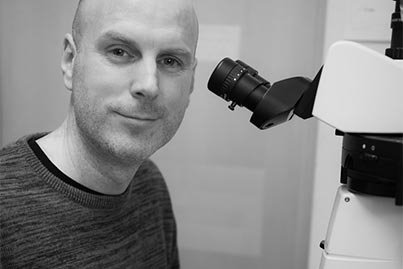Olov Andersson recipient of The Leif C. Groop award for outstanding diabetes research

Olov Andersson, docent at the Department of Cell and Molecular Biology at Karolinska Institutet, is the recipient of The Leif C. Groop award for outstanding research for his research in zebrafish that could lead to new treatments for diabetes. Awarded by the Lund University Diabetes Centre and sponsored by Novo Nordisk Sweden.
Sara Liedholm, from Lund University Diabetes Centre, asked Olov about getting the Leif C. Groop award for outstanding research:
- It is terrific for our research to be recognised in this way, particularly when it comes from colleagues who are diabetes experts. In addition, it is inspiring that others are interested in our research direction; it gives us additional motivation to push this particular research front forwards, says Olov Andersson, who heads a research team in cellular and molecular biology at Karolinska Institutet.
Create new cells
The aim of their research is to create new beta cells from stem cells or find other ways of increasing the number of insulin-producing cells.
- You can, for example, stimulate the remaining beta cells to divide and increase in number, or stimulate other cell types to change fate so that they start to produce insulin (i.e. cellular reprogramming). Above all, we can see that glucagon-producing alpha cells are flexible and can begin to produce insulin.
After completing a PhD in developmental biology, Olov Andersson chose to specialise in the formation of insulin-producing beta cells. Initially, he used mice in his research, but he soon switched to zebrafish.
Quick and simple
- Zebrafish are a more established model system abroad than in Sweden. When I started working with zebrafish, the development of beta cells and the pancreas had been described, but zebrafish had not yet been used to test new drug candidates for diabetes. It is a quick process to generate genetically modified zebrafish and test drug candidates on them simply by adding the drug to the water in which the fry swim, so I decided to exploit these advantages.
- We have 580 aquaria with different types of zebrafish, so we certainly see adult fish when we set them up for breeding, although we test potential new drugs on fry. I have learnt a lot of practical details about taking care of this type of aquarium facility, so if I fail as a researcher I can always open an aquarium shop.
How long will it be before a new treatment could become available to patients?
- Speculation on when a new treatment could become a reality for patients often misses the mark because there are many safety aspects that must be taken into account, e.g. if you stimulate the beta cells to divide there is always a risk that other types of cells could also divide and give rise to cancer. But certainly, our goal is not to develop veterinary medicine for fish; our hope is that our findings will eventually benefit patients, says Olov Andersson.
The prize is awarded annually to a younger researcher in the field of diabetes working in the Nordic countries. In addition to the honour, the recipient is awarded SEK 100 000.
Olov Andersson will accept the prize and hold an open award-winner’s lecture in the Jubilee Auditorium, Skåne University Hospital, on 19 March 2019.
Sara Liedholm
